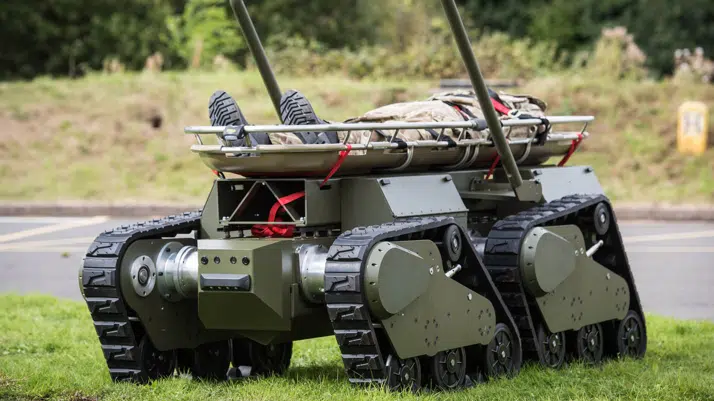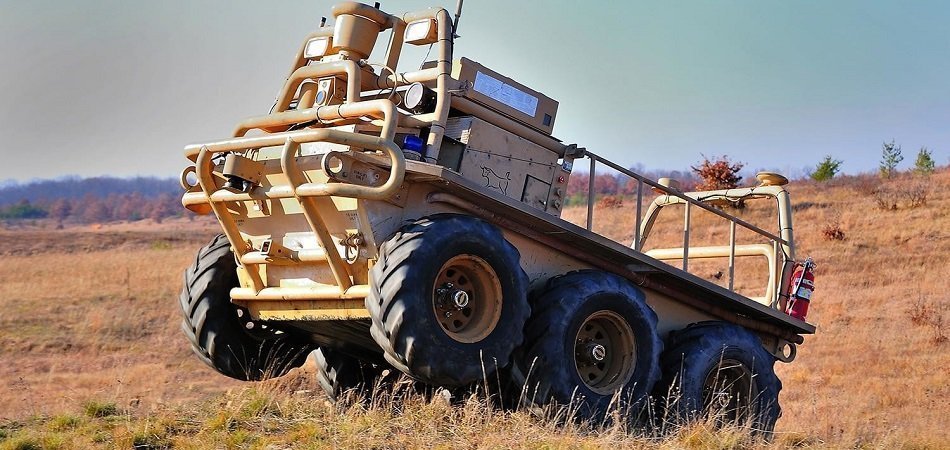It is clear the US military has taken an interest in exploring the capabilities of autonomous vehicles for the battlefield. Michael Griffin, Under Secretary of Defense for Research and Engineering for the US Department of Defense, reported to lawmakers in the United States Congress that 52% of casualties in combat zones have been attributed to military personnel delivering food, fuel, and other logistics.
Often these individuals are more vulnerable to attack because their tasks put them in easily trackable and exploitable positions. Removing more military personnel from the field with autonomous vehicles could reduce costs and injuries or deaths.
In this report, we will highlight the benefits of autonomous vehicles to militaries and the current capabilities of autonomous vehicles at the US government is using today. We will explore the products of three military defense contractors that offer autonomous vehicles to the military in order to give business leaders a window into the current applications and status of autonomous vehicles programs. These contractors include:
- Lockheed Martin offers an unmanned ground vehicle (UGV) for carrying the equipment, weapons, medical supplies, and rations of large platoons.
- Northrop Grumman offers an autonomous vehicle for improving airbase operations. It can purportedly tune into the airbase’s radio system to receive orders.
- BAE Systems is working on a medivac vehicle for transporting wounded soldiers back to base.
In the next section, we will describe the general method by which vehicles can be trained to act autonomously; this concept can be applied to all of the autonomous craft discussed in this report.
How to Get Vehicles to Drive Themselves – an Overview
Implementing artificial intelligence for autonomous vehicles is done through a combination of mechanical devices for physical vehicle operations, navigational instruments such as GPS monitoring, plus lidar and camera instruments for machine vision software.
A supervised learning process is first implemented to train the AI behind the self-driving vehicle. Numerous mounted cameras and other sensors are fixed all around the vehicle at various heights and angles that allow it to detect how the craft is moving. The software is trained on visual data of a human operator, showing the correct way a vehicle should be piloted in various real-world scenarios.
Certain aspects of this visual data would need to be labeled as key objects or scenarios of importance while operating on water, flying or driving. The algorithm would run through the labeled footage, and this would allow it to correlate the labels to the pixels that make up the labeled section of the footage, and those pixels to what happens next in the footage.
As a result, the algorithm would be able to tell that a certain group of pixels means “small rocks”, another means, “boulder,” and another means “front of the car,” for example.
Often autonomous vehicles have multiple systems working together for safe operation. There are sensors attached to the car breaks, for example. The algorithm would then correlate the sensor data to the dashcam data. Essentially, the algorithm would learn something to the effect of, “every time the pixels look this way on the dashcam, hit the break.”
The Benefits of Autonomous Vehicles to the Military
Autonomous vehicles could reduce workforce downtime. They can be designed to function 24/7 and they wouldn’t get distracted by sleep deprivation or hunger, for example. Additionally, human operators need to change shifts with their replacements; those shifts often require planning and costs, such as a patrol boat needing to dock to change operators. Long-term, focused missions are also made more possible with autonomous vehicles.
They also reduce the cost of operator training. It costs a lot to train a fighter pilot. Air Force Deputy Chief of Staff for Manpower and Personnel Services, Lt. Gen. Gina M. Grosso, has stated that it costs around $11 million to train a fighter pilot today. The monetary benefits of autonomous vehicles come in the long-term savings on these operational costs, as many of those costs are removed when an autonomous vehicle can conduct some of the missions those operators would otherwise. Such costs include pilot instructor salaries and food and lodging for the cadet and instructor.
In addition, personnel is kept out of harm’s way. A marine scout that once needed to perform actions on foot deep behind enemy lines could be replaced by a UGV.
Lastly, coercion and bribes are not effective on drones. Drones can not defect to an enemy force and cause damaging security breaches. Drones operated by artificial intelligence add additional security for a military looking to guard pivotal battlefield secrets.
Given these possible benefits and the demand for autonomous vehicles expressed by the US military, many of the world’s defense contractors have developed autonomous vehicles for the ability to bid with the US DoD and the militaries of other nations.
Our look into the current capabilities of autonomous vehicles by examining vendors offer autonomous craft to the US military will begin with the world’s largest military defense contractor, Lockheed Martin.
Lockheed Martin
Interested readers may want to know we covered Lockheed Martin’s numerous AI endeavors in our report on Lockheed Martin’s AI Applications for the Military – An Overview.
Lockheed Martin currently contracts with the US government on an autonomous UGV called the Squad Mission Support System or SMSS. The SMSS is meant to carry military equipment, heavy weapons, medical equipment, and food supplies of entire platoons of soldiers, allowing them to be less burdened while traveling on foot. Lockheed Martin was awarded an experimental contract by the US Department of Defense to push the use of autonomous vehicles to the front lines. As a result, the US Army has been using the SMSS in Afghanistan since 2011
The SMSS follows one soldier closely using machine vision and a 3D lidar sensor. The SMSS follows its assigned operator based on the visual appearance of the user; that operator is visually linked to the SMSS before each mission. That soldier is able to travel freely as the SMSS follows and responds accordingly to the operator’s actions. The soldier can also give travel orders to the SMSS via a touch screen controller or control it manually via the same remote.
Below is a short 3-minute video demonstrating the carrying capabilities and autonomous abilities of the SMSS:
By the end of 2011, the system’s dependable technology garnered six Safety Releases and a Safety Confirmation from the U.S. Army to work in close proximity with US soldiers. Lockheed Martin claims SMSS has logged hundreds of. hours with various US military users as recently as 2014, predominantly in Afghanistan, but in the continental US as well.
Dana (Keoki) Jackson is CTO at Lockheed Martin. He holds a PhD in Aeronautics and Astronautics from MIT. Jackson previously served as a NASA Research Fellow before his professional career at Lockheed Martin.
Northrop Grumman
Northrop Grumman seems to have a major focus on autonomous vehicles and is currently testing and manufacturing numerous autonomous vehicle initiatives for militaries around the world.
One DARPA-funded project currently being tested is an autonomous vehicle for use on airbases to aid in airfield related tasks, such as towing and equipment transportation. This vehicle is meant to monitor the airbase radio system and recognize when it is receiving an order. It will then act only on instructions directed at it. Northrop Grumman claims to be partnering with Uber for the project, called ACUGOTA.
An autonomous vehicle operating on an airbase could increase operational efficiency of airbase crews while making the airfield generally safer because less human operators will be required on the airfield. This project may also reduce the human labor costs of airbase administration.
Below is a short 3-minute video demonstrating how the ACUGOTA drives itself and the benefits an autonomous vehicle of this design could have to an airport or airbase:
In a previous report on the AI initiatives at the Top 5 US defense contractors, we discussed Northrop Grumman’s, DARPA funded, X-47B autonomous aircraft. Northrop Grumman’s X-47B launched and landed on an aircraft carrier at sea. Today, the ability for a human pilot to take-off and land in an aircraft while at sea is a test of a pilot’s skill.
The X-47B has also conducted the first autonomous mid-air refueling. Below is a video demonstrating the X-47B’s mid-air autonomous refueling:
BAE Systems
As the largest military defense contractor in Europe, one would think BAE Systems would have an autonomous vehicle further along in development. This reality highlights that the industry of vehicle autonomy for the military is new. BAE Systems seems has been given the approval to test and operate autonomous vehicles for commercial use in the United Kingdom. Speaking strictly on the defense sector, BAE Systems offers artificial intelligence consulting work on projects in addition to its Ironclad UGV although their current innovation on AI projects remains to be expressly seen.
BAE Systems offers a multi-purpose unmanned ground vehicle (UGV) called the Ironclad. BAE Systems claims the Ironclad can be outfitted with different equipment modules to solve a variety of battlefield problems, such as a remote-controlled weapons platform, a scouting vehicle, an explosive ordnance disposal device, and a medivac vehicle. This vehicle has been included in this report as a window into the capability space of a UGV for military use on the battlefield in the near future. The Ironclad currently is manufactured to operate via remote control, but BAE systems representatives have stated the Ironclad is currently being tested for autonomous functionality as well.

The key strategic action of an autonomous medivac vehicle is its ability to return to a forward operating base or medical station with a wounded soldier aboard, keeping other operators on the front lines. Traditionally, the transportation of wounded soldiers to a medical station on the battlefield has been executed by one or two soldiers, thus removing those soldiers from acting on the front lines until they return.
BAE System has contracted with the US Army, Royal Saudi Air Force, the Royal Saudi Navy, the Saudi Ministry of Interior, and the Royal Saudi Land Forces on numerous military contracts.
Nigel Whitehead is CTO at BAE Systems. Nigel is a Chartered Engineer, a Fellow of the Royal Aeronautical Society and a Fellow of the Royal Academy of Engineering with 33 years of experience in military defense systems.
Header Image Credit: Digital Trends




















